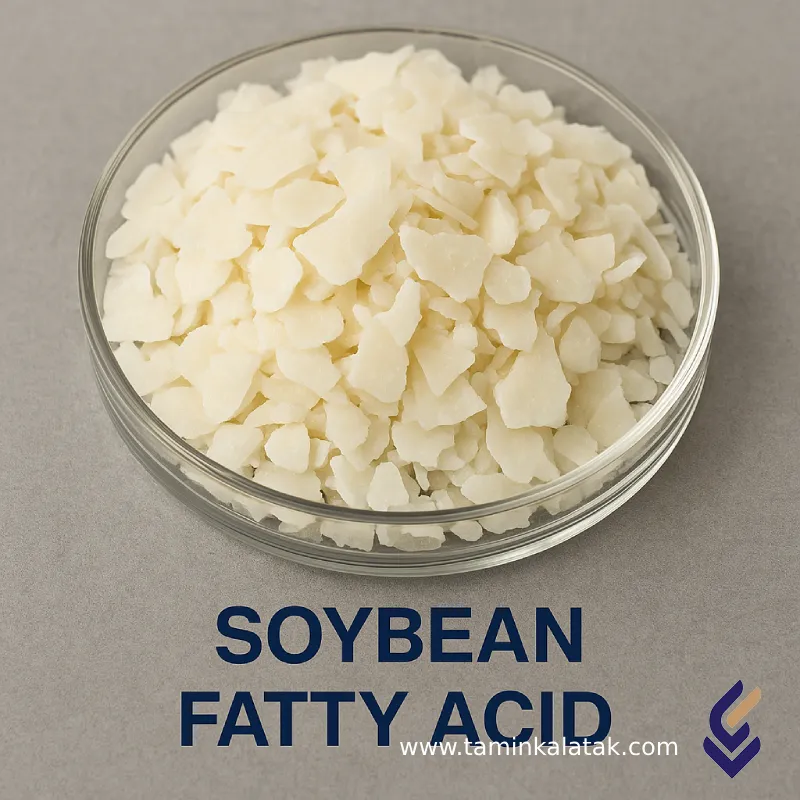Soybean fatty acid
Soybean Fatty Acid is one of the natural derivatives obtained through the hydrolysis or saponification of soybean oil. This compound consists of both saturated and unsaturated fatty acids, which are widely used in chemical, cosmetic, and industrial products. Its main components include: Linoleic acid (≈51%), Oleic acid (≈23%), Palmitic acid (≈10%), and Stearic acid (≈4%).
Structure of Soybean Fatty Acid
The chemical structure of soybean fatty acid consists of long hydrocarbon chains with a carboxyl group (-COOH) at one end. Depending on the number of double bonds, these acids are classified into two main categories:
-
Saturated acids: such as Palmitic acid (C16:0) and Stearic acid (C18:0)
-
Unsaturated acids: such as Oleic acid (C18:1) and Linoleic acid (C18:2)
This structure provides chemical and physical properties such as lubricity, thermal stability, and emulsion-forming capability.
Properties of Soybean Fatty Acid
-
Naturally derived from a plant-based source (soybean oil)
-
A mixture of saturated and unsaturated fatty acids
-
Odorless and tasteless after refining
-
Relatively stable at normal temperatures, but prone to oxidation when exposed to oxygen and light
-
Biodegradable and considered a green alternative to petrochemical derivatives
Applications of Soybean Fatty Acid
✅ Used in the production of soaps and plant-based detergents
✅ Serves as an emulsifier in paint, resin, and food industries
✅ Used in the manufacture of plasticizers
✅ Employed in the formulation of cosmetic and personal care products such as creams and lotions
✅ Utilized in the production of industrial oils and various waxes derived from industrial fatty acids
✅ Acts as a biofuel base (biodiesel) and is used in the drying oils industry (e.g., printing ink and paint)
✅ Used in the production of epoxidized soybean oil (ESO) for resins and plastics
Advantages of Soybean Fatty Acid
-
Plant-based and renewable (unlike many petrochemical materials)
-
Eco-friendly and biodegradable
-
Cost-effective and economical
-
Diverse fatty acid composition suitable for multiple industrial applications
-
Can be converted into epoxides, esters, and biodiesel for specialized uses
Disadvantages of Soybean Fatty Acid
⚠️ Sensitive to light and oxygen; may oxidize without proper storage
⚠️ Requires refining to remove impurities (such as soap, protein, and phytosterols)
⚠️ Thermal stability fluctuates without antioxidant additives—quality may degrade at high temperatures
Price of Soybean Fatty Acid
Soybean fatty acid is one of the most important derivatives of soybean oil in various industries. Its unsaturated nature and diverse chemical properties have earned it a significant place among plant-based fatty acids.
Several key factors influence its market price:
-
Purity grade and refining quality:
Soybean fatty acid is available in different grades—industrial, cosmetic, or pharmaceutical—each with a distinct price point. -
Fluctuations in crude soybean oil prices:
Since this fatty acid is derived from soybean oil, any global changes in the soybean market directly affect its final price. -
Order volume and packaging:
Bulk purchases in industrial drums or tankers reduce unit costs, while smaller quantities or special packaging tend to be more expensive. -
Production origin (domestic or imported):
Some local manufacturers supply this material domestically, but imported brands—especially those with international quality certifications—are usually more expensive.
Applications
| Applications | , , , |
|---|
Soybean fatty acid
| Solubility in water | Melting point | Density (at 20°C) | Physical appearance | Vapor pressure | Grade | CAS number | Chemical formula | Products |
|---|---|---|---|---|---|---|---|---|
| Almost insoluble or very slightly soluble (almost insoluble in water) | ≈ 13.4 °C (based on Oleochem for SOFA) | ≈ 0.89–0.90 g/mL | Light yellow oily liquid or semi-solid (translucent) | < 1 mm Hg (~<133 Pa) 22 °C | Industrial, usually non-pharmaceutical grade; free acid weight ≈45-55% for SOFA | 67701-08-0 (for SOFA mixture) / 68308-53-2 | Mixture; major composition: C₁₈H₃₄O₂ (e.g. oleic/linoleic) | Fatty acids C16–18 and C18 unsaturated Soybean Fatty Acid |







